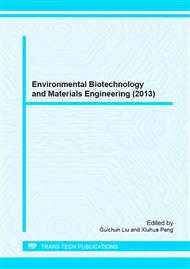p.232
p.238
p.242
p.247
p.253
p.258
p.263
p.268
p.274
Influence of Uniform Electric Field in Bioremediation of Oil-Contaminated Soils
Abstract:
Electrokinetic remediation is an effective technology to enhance bioremediation of oil-contaminated soil as the transport process of non-polar organic contaminants in soil was promoted under low-power direct current electric fields. In this study three treatments including the application of electric field treatment alone, inoculation treatment alone, and combination of the application of electric field and inoculation treatment were carried out. The results indicated that highest removal efficiency was 83% in couple of the application of electric field and inoculation treatment. TPH concentration decreased from 6000 mg.kg-1 to 2000 mg.kg-1 when a 30 voltage direct current electric field was applied to oil-contaminated soil for 10 min after 4 days. It was observed that dehydrogenase activity had no increase after application direct current electric field. However, the TPH degradation efficiency was 52% higher than the control treatment. GC analysis showed that n-alkanes (C14-C31) were preferentially degraded, and soil remaindered more low quality compounds after the application of electric field treatment applied 52 days. These results indicated that the application of electric field improved degradation of inoculated bacteria through promoting the transport of nutrients, such as nitrogen and phosphorous and electron acceptors.
Info:
Periodical:
Pages:
253-257
Citation:
Online since:
September 2013
Authors:
Price:
Сopyright:
© 2013 Trans Tech Publications Ltd. All Rights Reserved
Share:
Citation:


